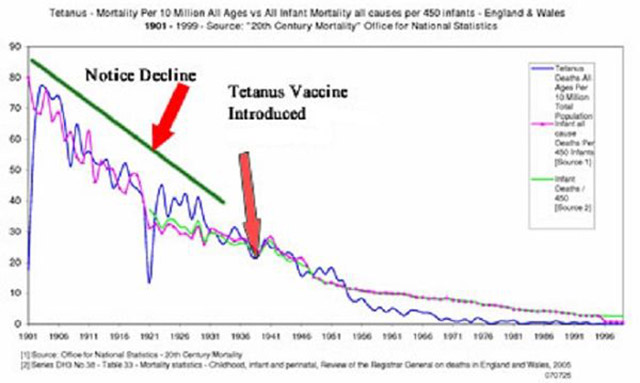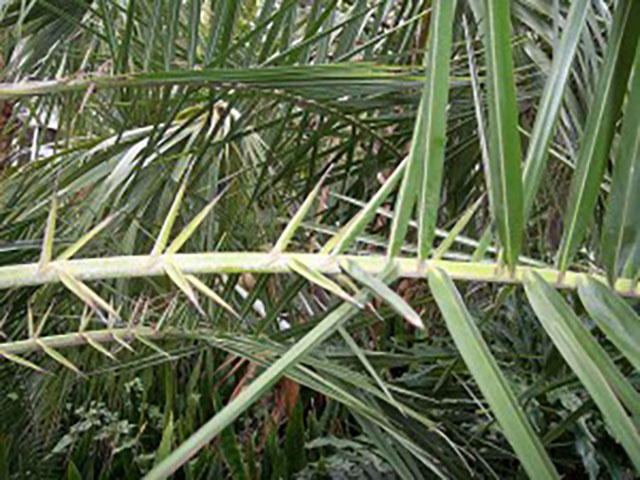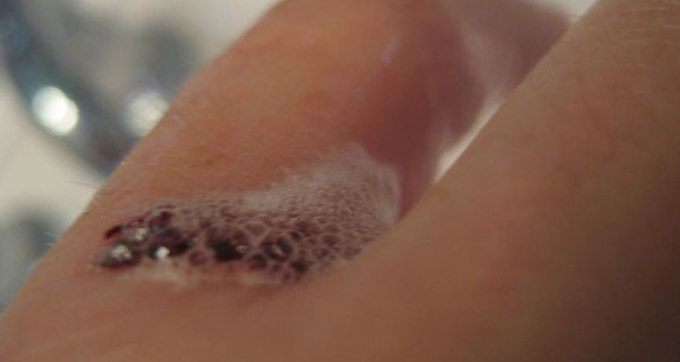What About Tetanus?
By Erwin Alber
Tetanus prevention involves good nutrition and particularly proper wound care. For a short but quite good summary of wound care click HERE. Personally, I would avoid antibiotic cream and especially ignore the reminder at the end of the article to “see a doctor if you aren’t sure if you’re up-to-date on your tetanus vaccine”. To read Sarah’s article ‘Tetanus Shot: Just as Bad as Other Vaccinations’click HERE I had my most recent tetanus booster 40 years ago and don’t plan to have another one, as the tetanus vaccine is in my estimation like other vaccines ineffective and can also cause severe reactions. HERE
This graph showing the incidence of tetanus in England shows what proportion of tetanus cases are fatal:

SOURCE
Do You Want to Remain Informed about the Latest Vaccine News?
The practice of administering a tetanus shot to people coming to a hospital or doctor’s surgery for emergency treatment say for a cut requiring stitches is nonsense because bleeding wounds are not a tetanus risk, and if it was a non-bleeding wound caused by a wood splinter or an animal bite, tetanus could possibly occur long before the vaccine could create any immunity, even if the vaccine was effective.

SOURCE: Green Book p.379


Passive tetanus vaccination with Tetanus Immuno-Globulin (TIG) would make more sense in such an emergency situation, at least from a medical point of view, which is described in this CDC document.

Tetanus bacteria can only live in an anaerobic (oxygen-starved) environment. This is why puncture wounds caused by stepping on a nail, wood splinters or animal bites which close over without being cleansed by bleeding are a greater tetanus risk than bleeding cuts and abrasions as the blood is itself an oxygenating agent. This is also why the few still occurring cases of tetanus affect mostly the elderly and much more rarely children because in the elderly poor blood circulation leading to poor oxygenation of body tissues may cause a problem. The elderly, in general, have poor nutrition and lousy vitamin C levels. Poor circulation is more often than not a result of nutrition, or sometimes the result of some sort of imbalance, resulting in plaque in the extremities.

Hydrogen peroxide is water (H2O) with an extra oxygen molecule that is loosely attached to form H2O2. That extra oxygen is highly unstable in the solution and vaporizes easily upon contact with other substances, thereby accounting for the fizzing that occurs whenever hydrogen peroxide touches the skin. Hydrogen peroxide solution is very effective for treating many infections. I have e.g. used hydrogen peroxide solution diluted further by half with water with good results for ear infections by dripping a few drops of the diluted solution into the affected ear. Unfortunately hydrogen peroxide has a drawback in that even diluted by half with water, it is harsh on wound tissue.

Because of its oxygenating effect on wound tissues, hydrogen peroxide prevents and cures tetanus, as documented in a German medical paper. The problem with hydrogen peroxide is however as already mentioned that even though it is very effective at killing bacteria including tetanus spores, it also kills the cells in the wound, which is why the solution needs to be diluted by about half with water and should be used for grazes rather than puncture wounds even though puncture wounds such as e.g. nail punctures, animal bites or those caused by wood splinters are more of a tetanus risk. The use of hydrogn peroxide for puncture wounds should be avoided altogether as the hydrogen peroxide may promote dead tissue inside the wound.

On grazes, hydrogen peroxide not only acts as a disinfectant, but also has a very useful function in that its “fizzing” and frothing action brings up tiny bits of dirt, grit and gravel to the surface which would otherwise stay embedded, making it much easier to clean them up. It also makes the surface cells go dead and white, which makes embedded stuff easier to locate. It therefore makes the job of cleaning surface wounds much easier. The dead cells may however hinder healing, which is why it is recommended to apply hydrogen peroxide only once, rather than repeatedly. Once hydrogen peroxide has been applied to a graze, it pays to remove the dead cells which are white, having been bleached by the hydrogen peroxide. This is relatively easy to do, as they mostly come off with a bit of persistent swabbing. Because this may hurt a bit, so if it does it pays to freeze the area with a packet of peas from the freezer, or by rubbing an ice cube over it, although this is in itself not exactly comfortable.
Tetanus bacteria live and feed on dead anaerobic cells. Putting hydrogen peroxide into a puncture wound under pressure by e.g. using a syringe without a needle may unfortunately cause serious problems. Putting stuff into a puncture wound “under pressure” forces INTO the wound tissue everything that is in the wound, be it bits of grass, dirt, glass or rust which may cause sepsis.

The instructions on the above label say”:
“Do not use on deep or puncture wounds, animal bites or serious burns.”
Using HP for puncture wounds is furthermore not recommended because it would kill many more cells inside the wound, thereby forming a necrotic area with who knows what in it. The fluid flow would be seriously disturbed and would make things for the body even more difficult. Also, if there are tetanus spores in there, the HP may or may not kill them. Ideally, puncture wounds need to be made to profusely bleed if at all possible. In the case of suspect wounds such as deep puncture wounds which close over before the wound can cleanse itself, homeopaths recommend a dose of homeopathic Ledum 30 as an extra precaution.

Homeopathic Hypericum 30 is said to be helpful in curing tetanus.
There is a 1967 German medical paper (Zentralblatt für Chirurgie 1967 Heft 13 (Central Journal for Surgery 1967, Volume 3) which documents the effectiveness of HPS in preventing and curing tetanus. However keep in mind to dilute the solution by half with water, to apply it to a wound only once, and to use it for abrasions and not puncture wounds.
Hydrogen peroxide should also only be used externally and should not be ingested as for one thing, the inexpensive hydrogen peroxide solution one can buy at virtually any drug store, chemist or pharmacy is not food grade. Food grade hydrogen peroxide can be used internally for various ailments, but only with great caution and only if one carefully follows reliable instructions. For information about the many uses of food grade hydrogen peroxide in one’s home click HERE
Finally a word of warning about the dangers, including the risk of tetanus, posed by palm trees with spikes, particularly phoenix palms.

Phoenix palm spikes have reverse barbs on them which tend to leave toxic vegetable matter behind if pulled out. The thorns should therefore not be removed at home, but need to be opened up under local anaesthetic and irrigated properly.

If you have children and have any spiky palms on your property it may therefore pay you to have them (preferably professionally) removed. Here are some links to articles about the topic:
Dangerous Palms HERE
Mat hospitalised in vicious Phoenix Palm attack! HERE
Palm Tree Puncture Wound Treatment HERE
Plant Thorn Arthritis HERE
RELATED INFORMATION:
– Vaccination Information Network
– A Life-Threatening Reaction To The Tetanus Vaccine
– Why One should always say no to the tetanus shot
– Other
– What Happened When I Refused My Tetanus Vaccine
– The Truth about Tetanus – Gianelloni Family
– A Dose of Reality: Tetanus Vaccines Fail To Protect
– Tetanus Shot: How Do We Know That It Works?
——————–
I am a 32-year-old male living in the USA. Two months ago I had a booster tetanus shot at a hospital for a cut finger. My previous tdap was 5-6 years prior when I went to paramedic school, with no reaction. This time, I had a bad reaction to the shot. I had flu like symptoms for 2-3 days, then leg weakness and tingling burning in feet and hands, and knee pain. Two months later I am better than the first month, but still have weak legs and tingling that comes and goes. My neurologist told me I have tetanus shot-induced peripheral neuritis and that it should resolve in 3-4 months.
——————–

